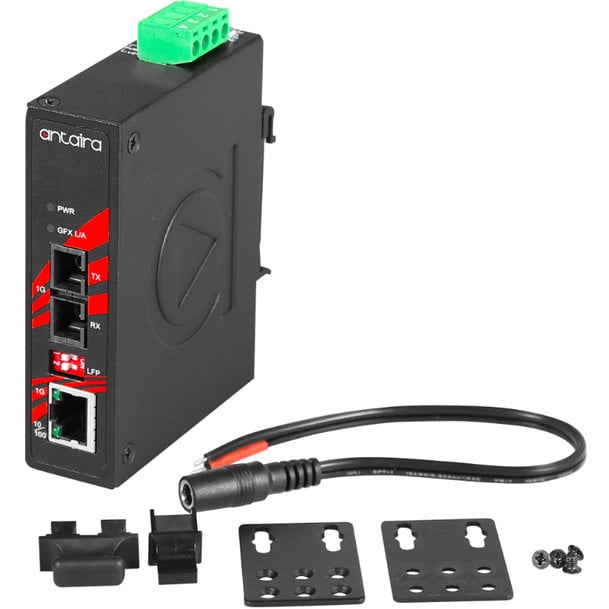www.industryemea.com
21
'23
Written on Modified on
Media Converters Bridge Gaps Between Divergent Media for Seamless Data Flow in Industrial Networks
Article by Henry Martel, Field Application Engineer, Antaira Technologies.

As manufacturing networks evolve, the need to interconnect diverse media types, such as fiber optic to Ethernet cables, becomes increasingly crucial. Enter industrial media converters – the unsung heroes that bridge the gap between disparate media, extend the reach of networks and bolster security and reliability in harsh industrial environments.
In this article, we delve into the integral role of industrial media converters, exploring how they help overcome distance limitations and enable the integration of machines, software, and systems into a cohesive whole.
Distance Limitations of Copper in Media Converters
Network managers frequently need to transmit data across distances greater than the 100 meters (328 feet) allowed by copper. For instance, consider an IP camera in a large warehouse mounted 500 feet away from the nearest available industrial Ethernet switch. A media converter can connect a copper port on the switch to a sufficiently long run of fiber optic cable that, in turn, connects to the ports on the switches and another media converter at the camera, extending reach without interruption or interference. To the network, it just looks like another Ethernet link.
Copper-to-fiber media converters are the most common design for these devices, typically featuring two ports: an RJ45 port on one side, and a fiber interface on the other. A copper-to-fiber media converter will be designed to convert Ethernet signals on a copper cable to light waves for transmission over fiber optic cables up to a maximum of 120 kilometers or approximately 74.5 miles. Signals move over fiber at the speed of light — a lot faster than electrons through copper — letting you convert link speeds from 10 Mbps to 100 Mbps or from 100 Mbps to 1000 Mbps.
Fiber is also immune to electromagnetic interference (EMI), radio frequency interference (RFI), and heavy surges that will cripple copper. Whenever multiple pieces of industrial equipment are interconnected, EMI and RFI are produced, creating adverse effects on data transmission across copper cabling. Only fiber optic cabling can protect data transmission from EMI, RFI, and surges.
Most conversion applications require a pair of media converters, one at each link, although this isn’t always the case. Fortunately, since media converters work with bidirectional links, the same model or device can convert copper to fiber at one end and from fiber to copper at the other.
While linking fiber and copper is the most common application for media converters, they can also link single-mode connectors to multimode fiber optics or extend the data transmission distance of a multimode network. Fast Ethernet, Gigabit, and 10 Gigabit port speeds on media converters are available to cover the most used interfaces today. Serial-to-Ethernet media converters are also available that convert RS232, RS422 or RS485 serial communication to Fast Ethernet, so older serial-based devices like serial PLCs are easily connected to support a TCP/IP network.
Versatility is extended to the mounting of media converters. Chassis-based solutions support high-density “mix and match” conversion applications in data centers, switching rooms, and LAN closets. Standalone media converters are highly compact, lightweight, and cost-effective. Because they are DIN-rail mountable, standalone media converters are ideal for space-restricted control cabinets, switches, and distribution boxes. Yet another choice is slide-in media converter cards installed inside a switch chassis or PC.
As with Ethernet switches, media converters come with either managed or unmanaged options. Along with their essential duties, managed media converters provide fault detection, remote configuration, and network monitoring features. Power over Ethernet (PoE), which combines power and data on one cable, is another useful function found on many media converters nowadays. PoE-enabled converters make fast work of deploying IP cameras, access control doors, WAPs, and other PoE-compliant devices. Some PoE converters can reset remote-connected devices by performing a power cycle to solve a problem, saving the hassle of having a technician dispatched to the site.
No matter which media converter product you choose, you’ll find their use extremely simple and cost-effective. Without a converter, networks that need to connect fiber to Ethernet would have to undergo a full-scale fiber optic network upgrade or the network administrator would need to buy additional industrial switches to bridge the gap between far-flung Ethernet devices. In addition, media converters can save money by simplifying the increasingly popular fiber-to-desktop process due to their ability to withstand high bandwidth.
Industrial Engineered for Industrial Environments
So far, we have only discussed media converters in general terms. Not all media converters offer the same protection against threats faced in industrial settings. As you are aware, industrial and remote locations expose network devices to harsh conditions detrimental to their service life — and media converters are no exception. Extreme temperatures, dust, dirt, water, poor power quality, and vibration will quickly wreck the function of a non-hardened media converter.
High-quality industrial media converters are housed in metal enclosures rated for ingress protection of IP30 or higher, along with defense against severe temperatures, loud vibrations, power supply interruptions, or worse. Thanks to these sturdy qualities, industrial media converters are suitable for outdoor traffic control, IP video surveillance, manufacturing facilities, wastewater treatment facilities, and factory automation.
www.antaira.com

